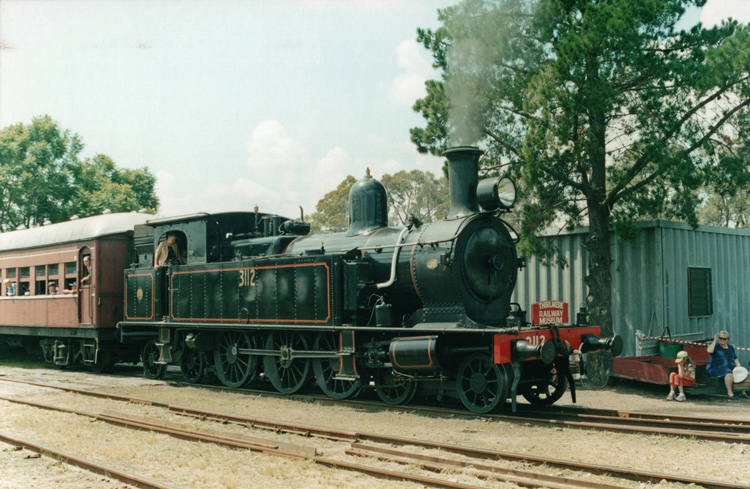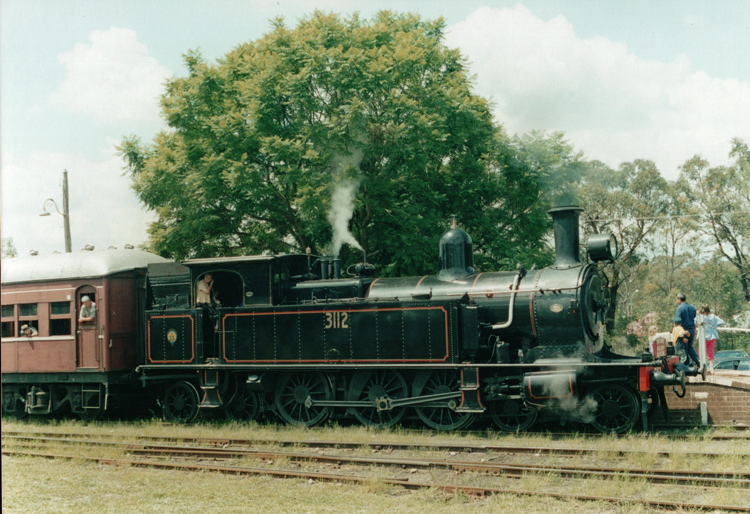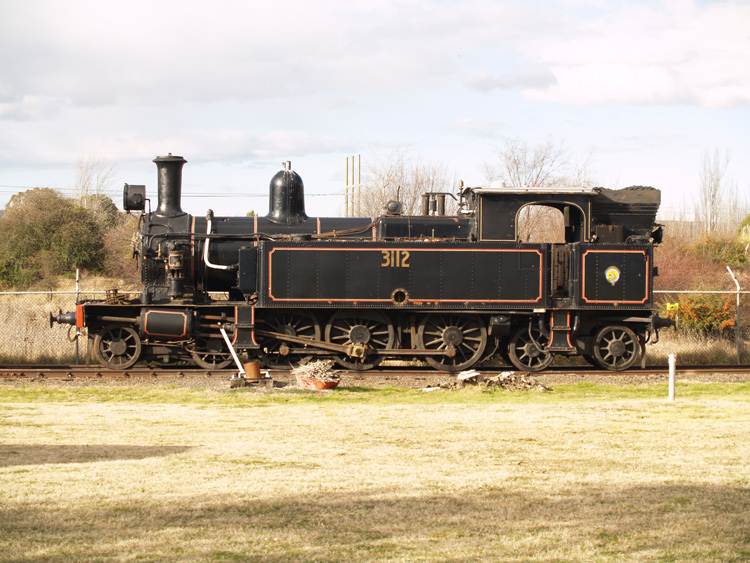|
|
3112 Goulburn Roundhouse Museum |
|

3112 departing Thirlmere with one of the NSWRTM’s regular Loop
Line tourist trains. 3 March 2002.
|
Builder |
Manchester |
|
Builder’s Number & Year |
5807
of 1914 |
|
Wheel Arrangement |
4-6-4T |
|
No. in class |
(C)30T
class – 77 (4-6-0 Tender) (C)30
class – 68 (4-6-4T) |
|
This locomotive
was built for Sydney suburban passenger duties, originally carrying the
number S 1240 of the S 636 class. The design proved very successful and the class
grew to 145 class members, with repeat orders from Beyer Peacock & Co and
the NSWGR Eveleigh Workshops. They became the (C)30 class in the 1924
renumbering scheme, with S 1240 renumbered to 3112. Following
the electrification of the Sydney suburban system, 77 class members were
converted to 4-6-0 tender configuration for mixed traffic use on country
branch lines. The converted locomotives were known as the (C)30T class. 3112 was
one of the last (C)30 class locomotives in NSWGR service when withdrawn in
February 1972. It languished at Enfield Depot until purchased for the Lachlan
Vintage Village, Forbes in October 1974. 3112 was stored for a few years at
Parkes before reaching the Lachlan Vintage Village around 1979. The Lachlan Vintage Village
was an interesting local history museum featuring relocated historical
buildings, a recreated Aboriginal camp and other displays relevant to the
region. From a railway perspective it included a 2’ gauge line using ex-sugar
industry locomotives and a standard gauge railway which ringed the site. Unfortunately
the Lachlan Vintage Village did not succeed as an ongoing concern and the
railway assets were progressively sold off. Standard Goods loco 5367 was sold
to the Lachlan Valley Railway, the ex-Sugar industry locomotives passed into
private hands and the remaining standard-gauge steam locos 1919 (on gate
duty), 3112 and 6042 went to auction in November 1986. 3112 was purchased
privately by the late Barry Tulloch and subsequently restored for main line
duties at Cowra Depot with the assistance of a group of supporting volunteers. 3112 was
very active in the NSW steam scene from 1988 onwards, with highlights
including a trip to Melbourne for the ‘AusSteam 88’ railway festival. 3112
participated in various rail tour operations around Sydney in the following
years, occasionally double-heading with sister 3137 at the NSWRTM Festival of
Steam. 3112 also participated in various community events and historical
re-enactments, including occasional trips on the North Shore line and the
branch to Lavender Bay. During the 1990's it was normally housed at the old
Eveleigh ‘Large Erecting Shop’, together with 3801 and 3830. (As an aside - I
always found Barry Tulloch and members of the supporting group to be very
friendly and accommodating during my encounters with them.) In 2007,
locomotive 3112 changed hands and the new owner has arranged storage in
Canberra on a private siding adjacent to the Canberra Railway Museum. Although
nominally operational, I understand 3112 is not currently in use; perhaps it
requires some repair or recertification. Hopefully new owner will facilitate
the return to service of this fine locomotive so it can continue to give
pleasure to many. For
further information and historical photographs of the (C)30 class
locomotives, readers are directed to Ron Preston's excellent book ‘Standards
In Steam - The 30 Class’ published by the New South Wales Rail Transport
Museum. A Wikipedia page for 3112 also provides
more information about this locomotive and its preservation history. Update: A
visit to Goulburn Roundhouse
on 25 Mach 2023 found 3112 receiving mechanical attention over the drop-pit. I understand the loco is now based at Goulburn. |

3112 under the Jacaranda tree at south end of Thirlmere
station. 3 March 2002.

3112 in storage on a private
siding in Canberra on 5 August 2012.
(This picture taken via
the webmaster craning his camera over the fence from the adjacent Canberra
Railway Museum!)
This view highlights the
symmetry of the 4-6-4 wheel arrangement, ideal for bi-directional running.
It can also be seen how
the bunker sides have been raised for increased coal capacity.
References
|
a |
‘A
Compendium of New South Wales Steam Locomotives’ compiled
by Alex Grunbach, published by the Australian
Railway Historical Society, New South Wales Division, 1989. |
|
b |
‘Standards
In Steam - The 30 Class’ by Ron Preston, published
by the New South Wales Rail Transport Museum, 1985. |
|
c |
Webmaster's observation or comment |
Page updated: 13 May 2023
|
Government Railways: |
|
|||||||||
|
Private & Industrial Railways: |
|
|